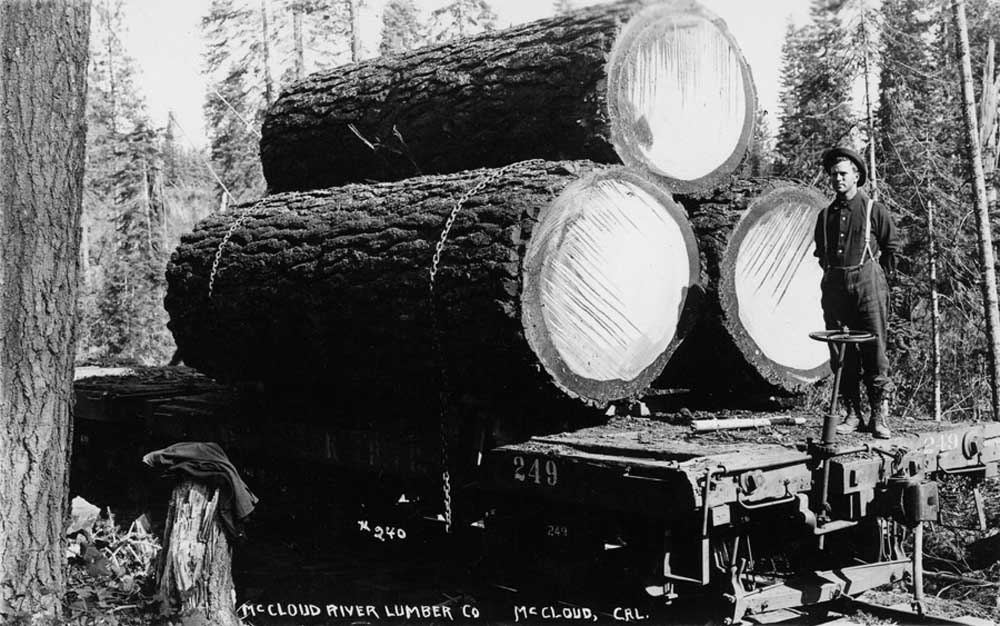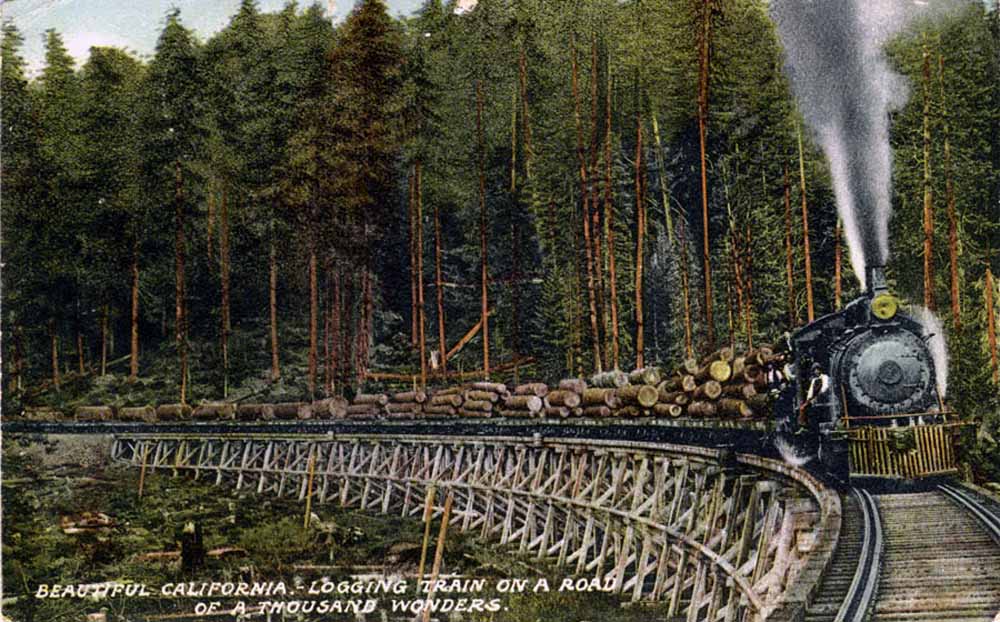|
McCloud River Lumber Company:
The Logging Railroads |
|
|
|
Loggers recognized early on the potential railroads held to move logs from the woods to the mill. Loggers had started using carts and wagons to haul logs overland for longer than anyone could remember, and it was only a matter of time before they started building primitive railroads, though the "rails" on a number of these early operations were wood poles laid end to end. Claims for the first true logging railroad run from Fox, Weston & Bronson of Lindley, New York, in 1852 to Scott Gerrish in Michigan in 1876. The widespread adoption of logging railroads in the following decades really allowed the lumber industry to become a dominate economic and cultural force, as the ability to efficiently move logs over ever increasing distances by rail allowed lumber mills for the first time to become large industrial facilities and remain in one place for extended periods of time. The McCloud River Lumber Company planned to use logging railroads from the start, and it built the first spurs into the woods as soon as the McCloud River Railroad reached the sawmill. By 1907 the lumber company reported 30 miles of spurs in use, a number which remained relatively constant for years. The patterns of logging railroad construction and operation repeated itself endlessly across the landscape as the loggers moved from one stand of trees to the next. The logging engineers working far in advance of the harvest activities would draw conceptual maps of what they deemed the most efficient way to haul logs out of the forests, given such variables as tree densities, relative species abundance, topography, and planned logging methods. McCloud River Lumber Company logging superintendent F.F. Spencer summed the process and considerations up nicely in a presentation he made to the 1912 Pacific Logging Conference that was also printed in the Timberman magazine in a paper titled "Modern Sugar and Yellow Pine Logging Operations in California". At the time the lumber company operated five camps, each cutting an average of sixty thousand board feet a day. A subsequent report on his presentation and the paper read as follows. "The McCloud logging operation was divided into three camps that logged with big wheels and two camps that logged with donkey engines. The big wheels were more advantageous on thin stands and the skidders were better on thick stands. The wheels were better on level ground, but the skidders were required to reach places too steep for the wheels. Both kinds produced equal amounts of timber, but the support systems varied. In the wheel logging sites, the haul distanced were kept at .25 miles or 440 yards, while on the donkey sides the haul distances ran between 500 and 600 yards. The wheel sides yarded their logs directly to the main line, which was served by rod locomotives requiring less than four percent grades and less than 16 degree curves, with a "very good roadbed". The donkey sides, on the other hand, were served by two Shays, "taking the loads from the yarders and delivering them to such points on the spurs or the main line that the rod engines can safely reach". Spurs on the donkey sides were built with six percent grades and twenty-five degree curves. In practice, then, the donkey sides had cheaper railroads than the wheel sides, but they required additional locomotives and additional handling. The decision about technologies had to made on a cost/benefit basis: "The location of the spurs is determined by the chief engineer working in conjuction with the logging superintendent and the timber cruiser. Each of these naturally views the spur from a different agnle, but with the same end in view- that of getting it located to the best possible advantage for bringing the timber out with the least cost per thousand feet of logs per mile of track"." All told the McCloud River companies built many hundreds of miles of logging railroad trackage during the sixty-seven or so years of the rail logging era. Typically a mainline spur would be built along the edge of the next stand of trees to be harvested, with a sequence of spurs then built usually perpendicular to the "main line" through the stand. The type of logging as described in the above paragraph determined the spacing of the spurs, which ranged from 2,640 feet on the wheel sides up to 3,600 feet on the donkey sides. Spur spacing shrunk to 2,000 feet apart with the reduced yarding distances described in the Donkey Logging page in the Logging the McCloud Woods segment of this section, then increased back to 3,000 feet with the adoption of tractor logging. Spur spacing then got increasingly farther apart as the effective reach of tractors increased. Maps of the logging railroads show a dense network of trackage covering an area, but only the spur(s) in the active logging area would have been in place at any one time. The lumber company employed large steel gangs through the rail logging era that kept busy continually removing spurs in logged over areas and building the spur network into the next stand of trees to be logged. |
|
|
 |
|
Postcard view of one of the early 28-foot flats with an impressive load of old growth Ponderosa pine. Jeff Moore collection.
|
|
|
| In the first years of operation, the lumber company contracted most of its railroad work out to the railroad company. This arrangement lasted until 1919, when the lumber company
assumed all operations and maintenace of the logging railroads. The lumber company thereafter employed its own crews, but leased all rails and almost all railroad equipment from the railroad. The only rail equipment
the lumber company owned were the three locomotive cranes, two Plymouth switchers, some specialized logging equipment, and the two crew transport vehicles, all of which are detailed in the Equipment section of this website. The logging railroad train crews lived in the camps with the loggers. In a typical day they tended to make three trips a day out of the camp, an early run in the morning to take the loggers and a first set of empty cars out to the woods, a mid-day run to the landing to pull the loads from the morning and deliver more empties, and then a final run at the end of the day to get the afternoon loads and bring the loggers back to camp. The Red Goose and the converted truck eventually took over the job of delivering loggers to and from camp, later replaced by buses. Log loads would be delivered to the McCloud River Railroad usually at sidings near the camps on the railroad main line, where railroad freights operating out from McCloud would swap the loads for more empties. These trains also included supplies, fuel, water, and other needs for the men and equipment working in the woods. The transition to the semi-permanent logging communities translated into increasingly longer log hauls between the woods and camp, and in the White Horse operations the lumber company crews also took log loads all the way to Hambone. In the final years of operation the lumber company maintained two active camps, the first at Pondosa and the second at White Horse, Widow Valley, and then Kinyon. Logging railroad operations out of Pondosa lasted until late fall of 1955 and were steam powered to the end. The railroad operated the lumber company trackage out of Burney after that extension opened, and loggers out of Pondosa continued trucking logs to a reload at Ditch Creek. The Kinyon camp supported logging operations in the mountains south of the McCloud River and was home to the lumber company's GE 70-ton diesel during its short tenure on the property. All logging by rail ceased within weeks of the US Plywood takeover. |
|
|
 |
|
Perhaps one of the most heavily used photos from the early years of the McCloud River operations is this one of
the #8 and a log train on the curved trestle a few miles east of Bartle. This is a colorized version of the postcard
from Southern Pacific's "Road of the Thousand Wonders" postcard series. Jeff Moore collection.
|
|
|
|
Below are a links to pages about the various aspects of the Lumber Company operations.
Loading Logs at the Landing Log Train Photos Winter Railroad Operations Wrecks Miscellaneous Photographs |
|
|